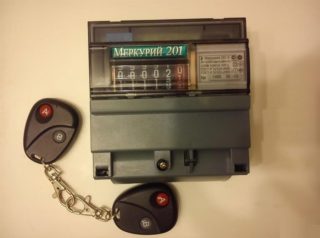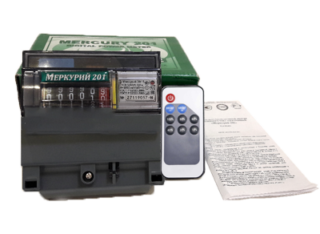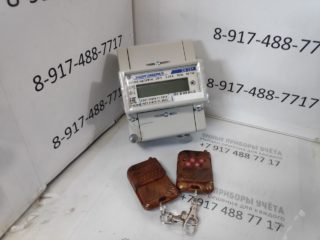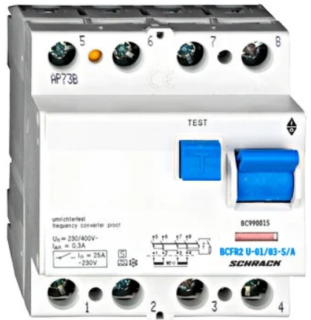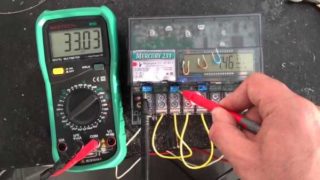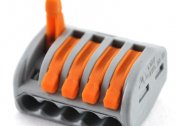The ability to remotely control an electric meter is considered a significant advantage of operating various types of accounting equipment. Some of them are often installed in a place inaccessible to the operator (on a high voltage pole, for example) and require special measures to be stopped in case of emergency. This option provides an electric meter with a remote control that allows you to turn off the meter, while at a certain distance from it.
Design and principle of operation
To stop a device called a “smart power meter with a remote control”, it’s not necessary to approach the device itself and perform any actions with it. The design of electronic smart products does not contain mechanical or electronic components like coils. Instead, sensitive solid-state elements that respond to the effects of remote control radiation are built into devices of this class. In addition, electricity meters with control panels include:
- a transformer unit that converts the mains voltage to the value necessary for the operation of the electronic module;
- a receiving unit that responds to signals from the remote control and recognizes them;
- a control unit that converts these packages into a sequence of working pulses;
- executive relay module, interrupting the operation of the device on command from the operator panel.
At the signal of the operator, the pulses from the remote control arrive at the receiver, where they are processed and transmitted to the control device. Under his control, the command is decrypted and enters the executive node on transistor switches, disconnecting the energy meter itself from the electrical network.
"Charged" counters with PU
Intelligent or “smart” electronic metering devices in their circuit design differ significantly from other modern models of such technology. Electricity meters with a remote control are “charged” in such a way that they can significantly expand the functionality of the device. This applies to the following options:
- stopping the count of electrical pulses for one purpose or another;
- slowdown of the counting mechanism;
- Switching it to count mode once.
The concept of "charged" applies equally to those tricky tricks that are possible when working with this device.
Its opportunities are often used by amateurs to save on electricity, paying only a small part of the consumed electricity. To do this, it is enough to stop the metering device for a while, as a result of which its readings will not correspond to the real amount of energy consumed during the reporting period. But all these attempts to deceive the energy supplier are fraught with huge fines, so it is better for unreasonable fans to “profit” at someone else’s expense and not try to do it.
According to the current legislation, any attempts to turn off the meter even for a short time belong to the category of “theft of electricity”. They are punished with a fine of 3-4 thousand rubles for ordinary citizens, and up to 8 thousand rubles for legal entities. For organizations and industrial enterprises, this fine rises to 80 thousand rubles.
After detecting violations, the amount of the fine in all cases is constantly adjusted depending on the time elapsed since the start of the “saving”.The indicated figures are valid for the regional centers of Russia.
In large cities with developed infrastructure (Moscow and the cities of the Moscow region), the monetary value or the amount of penalties increases significantly.
To control a "smart" electronic device, a small keychain is used, resembling a similar remote control from a car. For different models that differ in their design and price, it is able to operate at distances from 20 to 500 meters. Obstacles encountered on the path of wave propagation (walls of houses, for example) somewhat reduce the radiation power and reduce this indicator. Inattentive users also need to know that the effectiveness of the control panel depends on the charge level of the power elements installed in its compartment.
Manufacturer point of view
To verify the legitimacy of the use of electric meters with remote control, just go to the official website of the manufacturer that manufactures these electronic devices. It contains complete information on a wide range of single and three phase metering devices.
It is especially noted that the cost of these products is much higher than that of conventional meters. They are mainly represented by two well-known models (Mercury and Energomera). These familiar to all samples of accounting devices are no different from ordinary meters, except that they have a remote control.
Types of smart electricity meters
By type of controlled voltage, all known samples of meters with PU are divided into single-phase and three-phase devices. Both types of metering devices on the market are represented by the Mercury brand. According to the method of accounting, they are single-mode or designed for several tariff plans (day and night, for example).
In accordance with the principle of dividing by operating voltage, single-rate models are designed for installation in the network 220-230 volts, and multi-tariff - for 380 volts.
Self-made metering device with tripping relay
The question of the independent manufacture of a three-phase meter with a control panel can be considered only as a one-time experiment for a more detailed acquaintance with the principle of operation. It makes no sense to make a request to Energosbyt, since no one will ever allow such an experience to be officially conducted. The algorithm for constructing a control circuit is most conveniently selected by analogy with a radio channel, where the transmitter has a generator of a certain frequency, and a receiver is installed in the counter itself.
As an executive (disconnecting) element in such a circuit, most users prefer to choose an electronic / electronic relay.
Given the fact that the device is often installed on a pole near the house, the range of the remote control is selected as much as possible.
Criteria for choosing the transmitting part of the device are described in many sources on the Internet. It is best to take the control circuit for turning on the TV as the basis of the remote control for stopping the meter, in the same way the receiver of the control signal is selected. Alteration of the finished radio frequency path from the TV is subject to one executive part, which is being finalized taking into account the requirements for interrupting the power line (220-380 Volts).
When designing this module, special attention is paid to the isolation between the control and end circuits, which protects the electronic circuit. circuit from failure. This will require optocoupler pairs or transformer isolation. The power contacts of the relays installed at the output of the device are calculated based on the maximum phase currents of up to 50 amperes. The optimal solution in this case is the use of electromagnetic contactors. In three-phase networks, the executive part is connected in series with the secondary windings of current transformers.In this case, you can’t do without the help of a professional electrician.
Manual and automatic power outage settings
Any electric meter with a remote control needs to be pre-configured, taking into account the requirements of the experiment. To do this, prepare the following measuring tool:
- A multimeter necessary for setting the operating modes of electronic and electrical components.
- An oscilloscope, through which it is possible to detect a control signal at the input of the receiver, and then trace the entire chain of its propagation by control.
- A screwdriver - to set the optimal operating mode of the sensitive element.
Since all the input nodes of the disconnecting device (receiver and control module) are taken from a working television system, the setup of the device is reduced to debugging the executive unit. After giving the command from the remote control, the oscilloscope traces the signal flow to the executive relay and makes sure that the corresponding contact is activated. To configure the manual mode, it is enough to adjust the response mechanism of a conventional button, the contacts of which are connected in parallel with the executive module.
All the materials reviewed are not a call to stop the meter to deceive the electricity supplier. They represent an attempt to analyze the possibilities of the very principle of interruption on branded products, modified taking into account the task.
